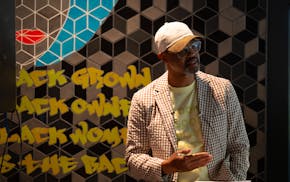Minneapolis is the economic engine of Minnesota, and downtown Minneapolis is the economic engine of the city.
It needs to stay that way, not just for the good of the city but for the state and broader Upper Midwest.
But that's harder than ever because downtown Minneapolis, like other city centers, lost to remote work many of the people who fueled that economic engine.
What's more, the remote work phenomenon drove people out of cities entirely, to suburbs, small towns and places near water or mountains.
Both Hennepin and Ramsey counties lost population in 2021 and 2022, census data show. Financial analysts at Minneapolis Public Schools, in a recent summary of the district's fall toward insolvency, said MPS is seeing the number of children in the city plunge.
So when I asked last month to meet someone at City Hall who is thinking big thoughts about the future of downtown, I expected to be introduced to an earnest but wild-brained person in the economic development office.
Instead, I was invited to meet Mayor Jacob Frey. And he invited about a dozen other city officials to listen to us talk. The discussion was enlightening — clearly Frey wanted to signal he cares a lot about downtown — but not as wild as hoped.
"There will be obviously a drop in the number of commercial buildings downtown," Frey said. "But there doesn't need to be a drop in the number of buildings that are used and filled with people."
As a council member representing a portion of downtown a decade ago, and as mayor since 2018, Frey built a record as someone who cared a lot about development and, most especially, replacing the surface parking lots around downtown with apartment buildings.
Over the last 10 years, that turned out to be quite a successful strategy. This is particularly true in the North Loop and on the east side of downtown after the Metrodome was torn down to make way for U.S. Bank Stadium, and after the Star Tribune sold its five city blocks that were turned into office buildings, apartments and a park.
Post-pandemic downtown would have been bleak if not for the explosion of apartment and condo construction, Frey said. "We've made the right decisions over the last six years or so to provide additional housing supply even with significant political headwinds," he said.
The question now, said Andy Gittleman, president of the Downtown Minneapolis Neighborhood Association, is: "How do you create a downtown that is really geared towards supporting the residential community that actually lives downtown?"
The answer, Frey said, is some quality-of-life additions, such as another park and a school, and local rather than national retailers.
"That's part of what makes the city exceptional and that's a big part of what we're leaning into," Frey said. A report from a task force on attracting new retailers downtown is expected soon.
Some older office buildings may be reconfigured for residences, Frey said, but that's not possible with the towers built since the 1970s that have large floor areas. They will need to refill with businesses, which could take years.
But some former warehouses that became offices in the last 30 years could be converted to lofts and apartments. City officials are talking to several landlords in the Warehouse District near Target Center about that.
In recent weeks, Frey touted another benefit to the surge of apartment building in Minneapolis. Median rent grew a mere 1% annually in the 2017-2022 period, Pew Research reported last month.
"Rent growth is much slower in jurisdictions that have allowed more housing. That's the conclusion," Frey said.
That's also basic economics — and a great argument against rent control, a perennial issue raised in the city.
Gittleman said downtown residents would like to see the skyway system opened past 6 p.m. But, Frey said, with the skyway maintained by various office buildings, owners will need to see enough people back to justify the cost of later hours.
As I've written before, governments are less responsible for economic well-being than businesses and individuals. To make downtown thrive, more businesses should bring their workers back to offices regularly. Frey is pushing for three days a week.
I'd also like to see some innovations that encourage people to be downtown. For instance, let's have dynamic pricing for parking on downtown streets and ramps. The city already has a great app to pay for street parking. It should be possible for rates to vary not just by location but time. That already happens in parking lots near stadiums and theaters for events.
And of course, the city needs to keep making progress on public safety and policing. Crime data show some noteworthy improvements in major crimes like homicide and robbery this year. Even so, perceptions about the safety of Minneapolis will take time to catch up.

Ramstad: Gov. Walz, things are not getting done in Minnesota

Ramstad: AI is English-centric, but it's picking up Hmong quickly

Ramstad: Minneapolis' Camden neighborhood is rising. Houston White wants to keep it that way.

Ramstad: Minnesota's big businesses are in crisis with a common problem


